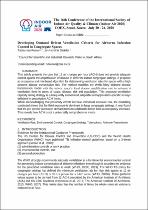 ResearchSpace
ResearchSpace
Developing demand driven ventilation criteria for airborne infection control in congregate spaces
JavaScript is disabled for your browser. Some features of this site may not work without it.
- ResearchSpace
- →
- Research Publications/Outputs
- →
- Journal Articles
- →
- View Item
| dc.contributor.author |
Van Reenen, Tobias H

|
|
| dc.contributor.author |
Grobler, Jan-Hendrik

|
|
| dc.date.accessioned | 2021-04-07T09:09:01Z | |
| dc.date.available | 2021-04-07T09:09:01Z | |
| dc.date.issued | 2020-07 | |
| dc.identifier.citation | Van Reenen, T.H. & Grobler, J. 2020. Developing demand driven ventilation criteria for airborne infection control in congregate spaces. http://hdl.handle.net/10204/11960 . | en_ZA |
| dc.identifier.uri | http://www.indoorair2020.org/data/IA2020_oral_session_list.pdf | |
| dc.identifier.uri | http://hdl.handle.net/10204/11960 | |
| dc.description.abstract | This article presents the case that 12 air changes per hour (ACH) does not provide adequate control against the amplification of disease in different indoor congregate settings. It proposes an occupancy and risk-based algorithm for determining ventilation rates for spaces with a high airborne disease transmission risk. The method modifies the Wells-Riley airborne disease transmission model with the indoor space’s local disease amplification rate to estimate a ventilation limit in terms of space, disease, risk and population. This proposed ventilation capacity sizing strategy is subsequently economical, adaptable and application-specific in ways deficient in prescriptive ACH limits. While acknowledging that proximity effects increase individual exposure risk, the modelling conducted shows that far-field exposure is dominant in large congregate settings. It was found that the per-person ventilation demand tends to a definable lower limit as occupancy increases. This reveals how ACH is not a universally comprehensive metric. | en_US |
| dc.format | Fulltext | en_US |
| dc.language.iso | en | en_US |
| dc.source | 16th Conference of the International Society of Indoor Air Quality & Climate (Indoor Air 2020), COEX, Seoul, Korea, 20-24 July 2020 | en_US |
| dc.subject | Airborne transmission | en_US |
| dc.subject | Congregate settings | en_US |
| dc.subject | Environmental control | en_US |
| dc.subject | Tuberculosis | en_US |
| dc.subject | Ventilation rate | en_US |
| dc.title | Developing demand driven ventilation criteria for airborne infection control in congregate spaces | en_US |
| dc.type | Conference Presentation | en_US |
| dc.description.pages | 6pp | en_US |
| dc.description.note | Paper presented at the 16th Conference of the International Society of Indoor Air Quality & Climate (Indoor Air 2020), COEX, Seoul, Korea, 20-24 July 2020 | en_US |
| dc.description.cluster | Smart Places | |
| dc.description.impactarea | Infrastructure Innovation | en_US |
| dc.identifier.apacitation | Van Reenen, T. H., & Grobler, J. (2020). Developing demand driven ventilation criteria for airborne infection control in congregate spaces. http://hdl.handle.net/10204/11960 | en_ZA |
| dc.identifier.chicagocitation | Van Reenen, Tobias H, and Jan-Hendrik Grobler. "Developing demand driven ventilation criteria for airborne infection control in congregate spaces." <i>16th Conference of the International Society of Indoor Air Quality & Climate (Indoor Air 2020), COEX, Seoul, Korea, 20-24 July 2020</i> (2020): http://hdl.handle.net/10204/11960 | en_ZA |
| dc.identifier.vancouvercitation | Van Reenen TH, Grobler J, Developing demand driven ventilation criteria for airborne infection control in congregate spaces; 2020. http://hdl.handle.net/10204/11960 . | en_ZA |
| dc.identifier.ris | TY - Conference Presentation AU - Van Reenen, Tobias H AU - Grobler, Jan-Hendrik AB - This article presents the case that 12 air changes per hour (ACH) does not provide adequate control against the amplification of disease in different indoor congregate settings. It proposes an occupancy and risk-based algorithm for determining ventilation rates for spaces with a high airborne disease transmission risk. The method modifies the Wells-Riley airborne disease transmission model with the indoor space’s local disease amplification rate to estimate a ventilation limit in terms of space, disease, risk and population. This proposed ventilation capacity sizing strategy is subsequently economical, adaptable and application-specific in ways deficient in prescriptive ACH limits. While acknowledging that proximity effects increase individual exposure risk, the modelling conducted shows that far-field exposure is dominant in large congregate settings. It was found that the per-person ventilation demand tends to a definable lower limit as occupancy increases. This reveals how ACH is not a universally comprehensive metric. DA - 2020-07 DB - ResearchSpace DP - CSIR J1 - 16th Conference of the International Society of Indoor Air Quality & Climate (Indoor Air 2020), COEX, Seoul, Korea, 20-24 July 2020 KW - Airborne transmission KW - Congregate settings KW - Environmental control KW - Tuberculosis KW - Ventilation rate LK - https://researchspace.csir.co.za PY - 2020 T1 - Developing demand driven ventilation criteria for airborne infection control in congregate spaces TI - Developing demand driven ventilation criteria for airborne infection control in congregate spaces UR - http://hdl.handle.net/10204/11960 ER - | en_ZA |
| dc.identifier.worklist | 24219 | en_US |





